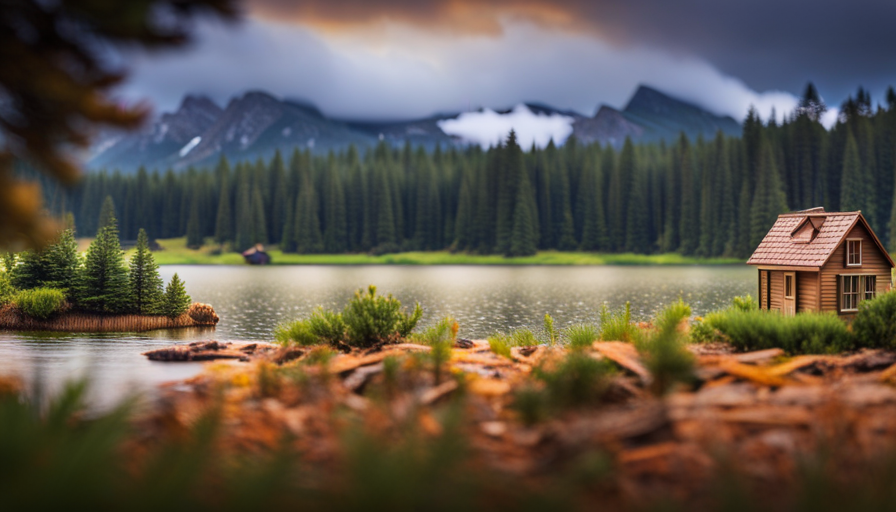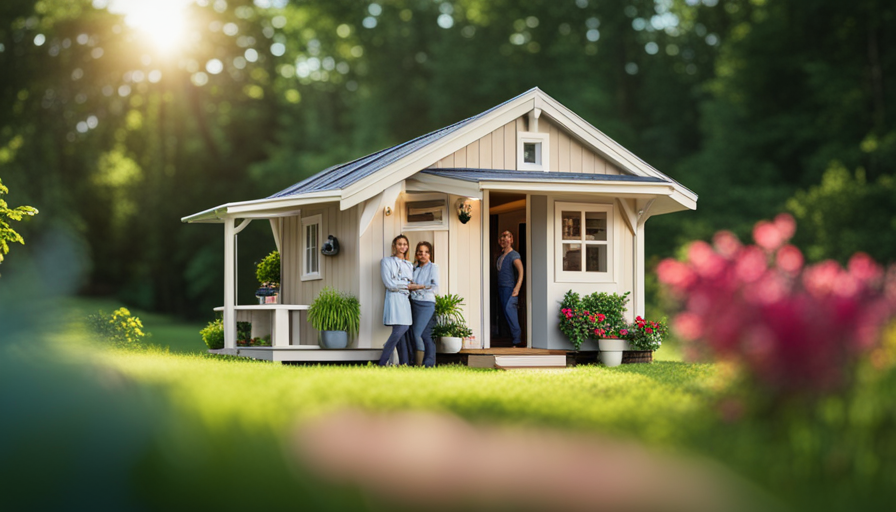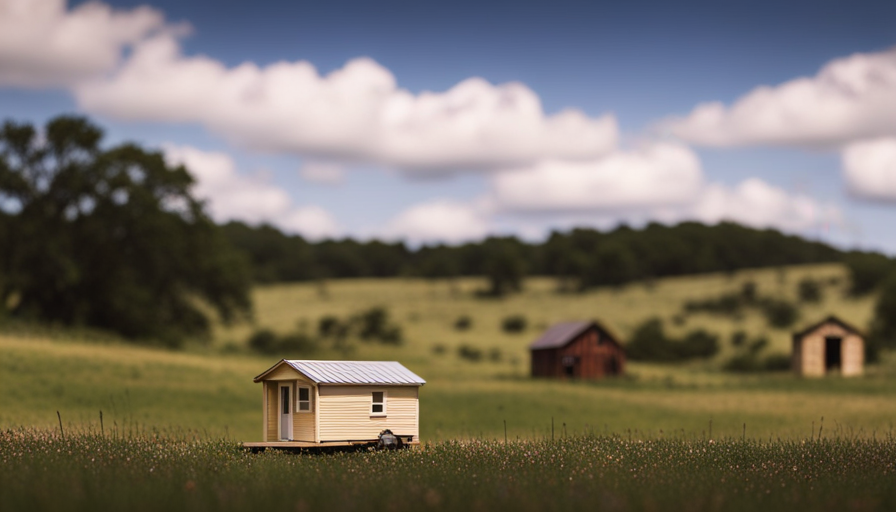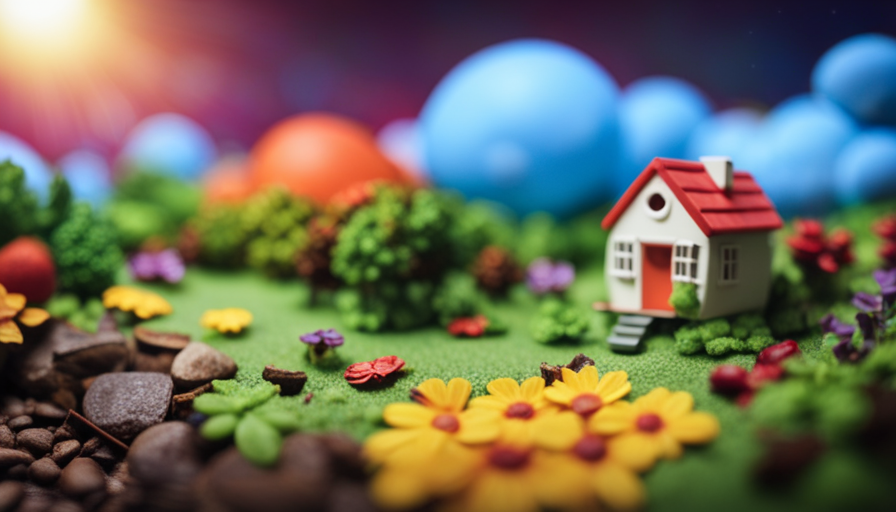Picture a scenario where your entire home fits in your pocket, giving you the gift of waking up each day to the breathtaking beauty of nature or the bustling streets of the city. Enter the world of tiny houses. These compact yet versatile dwellings are gaining popularity for offering a budget-friendly and environmentally friendly alternative to traditional housing.
But one question remains: where do you park your tiny house? In this article, I will explore various options for parking your tiny house, from backyard parking to tiny house communities and RV parks. I will also delve into alternative living arrangements, such as house sitting or work exchanges, and discuss the importance of researching local zoning laws and regulations.
Whether you’re a minimalist seeking a simpler way of life or an adventurous soul yearning for a mobile abode, this guide will provide you with the information you need to find the perfect spot to park your tiny house.
Key Takeaways
- Research local zoning laws and regulations before parking a tiny house to avoid legal complications.
- Explore options such as tiny house communities, RV parks, backyard parking, renting land or parking spots.
- Connect with other tiny house owners for valuable insights and recommendations on parking spots.
- Consider alternative living arrangements like co-housing, farm or homestead communities, campgrounds, or mobile tiny house communities.
Determine Local Zoning Laws and Regulations
You’ll need to research and understand the local zoning laws and regulations if you want to find the perfect spot to park your tiny house and avoid any unwanted legal complications. It is crucial to understand the legal restrictions imposed by the local government before you begin your search.
Each jurisdiction has its own set of rules and regulations regarding the placement and construction of tiny houses. By familiarizing yourself with these laws, you can ensure that you meet all the necessary requirements and avoid any potential fines or penalties.
To start, you should research building codes specific to your desired location. These codes dictate the minimum standards for construction, including safety regulations and structural requirements. You’ll need to ensure that your tiny house meets all the necessary criteria to comply with these building codes. It may be helpful to consult with local officials or a professional who’s knowledgeable about zoning laws and building codes in your area.
Understanding the local zoning laws and regulations will help you identify areas where it’s legally permissible to park your tiny house. Some areas may have specific zones designated for residential or recreational use, while others may have restrictions on the size or type of dwelling allowed. By conducting thorough research, you can narrow down your options and find the best areas to explore further.
With a good understanding of the local laws and regulations, you can now transition into the next section, where we’ll explore the option of researching tiny house communities and RV parks.
Research Tiny House Communities and RV Parks
Don’t fret, there’s a whole world of communities and campsites just waiting for you to nestle your cozy abode! When it comes to finding a place to park your tiny house, researching tiny house communities and RV parks is an excellent starting point.
Here are some key points to consider:
-
Research challenges: Investigate the rules and regulations of each community or park you’re interested in. Some may have restrictions on the size or type of tiny house allowed, while others may have specific requirements for utilities and amenities.
-
Benefits and costs of living in tiny house communities: Living in a tiny house community can offer a sense of camaraderie and shared resources. It can also provide opportunities for socializing and learning from others who’re on a similar journey. However, it’s important to weigh the costs, including monthly fees and potential limitations on personal space.
-
Analyze the advantages and disadvantages of parking in RV parks: RV parks may offer convenient amenities such as hookups for water, electricity, and sewage. They’re typically designed for short-term stays but can be an option for parking your tiny house temporarily. However, they may not provide the same sense of community as dedicated tiny house communities.
Transitioning into exploring backyard parking options, it’s essential to consider all the possibilities for finding a parking spot that suits your needs.
Explore Backyard Parking Options
Take a stroll through the lush green gardens, where hidden gems of backyard parking options await. When it comes to finding a place to park your tiny house, backyard parking alternatives can provide a convenient and cost-effective solution.
Many homeowners are open to renting out their backyard space, allowing you to park your tiny house on their property. This option not only offers a sense of community but also provides an opportunity to build relationships with the homeowners.
DIY parking solutions are another viable option for those seeking to park their tiny house in a backyard. With a little creativity and resourcefulness, you can transform a section of your backyard into a designated parking spot. This could involve clearing out space, laying down gravel or pavers for a sturdy foundation, and ensuring proper access to utilities.
Consider renting land or a parking spot to park your tiny house. This option allows you to have more control over the location and amenities available. Whether it’s a private parcel of land or a designated parking spot in a rural or suburban area, renting provides flexibility and peace of mind.
By exploring backyard parking alternatives and DIY solutions, you can find the perfect spot to park your tiny house. Consider renting land or a parking spot to further expand your options.
Consider Renting Land or a Parking Spot
Explore the vast possibilities of renting a piece of land or a convenient parking spot to unlock a world of endless opportunities for your cozy abode. When it comes to parking your tiny house, renting land or a parking spot can be a great alternative to buying your own property. Not only does it provide flexibility, but it also allows you to test out different locations and neighborhoods before committing to a long-term investment.
Renting land or a parking spot for your tiny house can be a cost-effective option compared to buying land outright. It eliminates the need for a large down payment and the financial burden of a mortgage. Additionally, renting allows you to avoid the responsibilities associated with property ownership, such as maintenance and property taxes.
However, it’s important to be aware of legal restrictions on tiny house parking. Different areas may have zoning regulations or building codes that limit where you can park your tiny house. Before renting a piece of land or a parking spot, make sure to research and understand the local laws and restrictions to ensure you are in compliance.
In order to find the perfect location for your tiny house, consider reaching out to other tiny house owners for recommendations. They can provide valuable insights and advice based on their own experiences. By connecting with the tiny house community, you can gain valuable knowledge and make informed decisions about where to park your tiny house.
Connect with Other Tiny House Owners for Recommendations
Connect with fellow owners of compact dwellings to gather valuable insights and recommendations for finding the ideal location for your cozy abode. Connecting with other tiny house owners is a great way to tap into a network of individuals who’ve already navigated the challenges of finding a parking spot for their tiny homes. By sharing experiences and tips, you can learn from their successes and avoid potential pitfalls.
One way to connect with other tiny house owners is through online communities and forums dedicated to the tiny house movement. These platforms provide a space for like-minded individuals to share their stories, ask questions, and offer advice. By actively participating in these communities, you can connect with owners who’ve faced similar challenges and have valuable recommendations for finding the perfect parking spot.
Another option is to attend tiny house gatherings or workshops. These events often attract a community of tiny house enthusiasts, including owners who’re more than willing to share their experiences and provide recommendations. Engaging in conversations with other attendees can offer invaluable insights and potentially lead you to discover hidden gems for parking your tiny house.
By connecting with other tiny house owners for recommendations, you can gain valuable insights and advice to help you in your search for the ideal parking spot. Once you’ve gathered these recommendations, you can then transition into the subsequent section about looking into co-housing or collective living opportunities.
Look into Co-Housing or Collective Living Opportunities
Delve into the world of co-housing or collective living, where like-minded individuals come together to create a harmonious and supportive community. This offers a unique opportunity to seamlessly integrate your compact dwelling into a vibrant and interconnected environment.
Co-housing arrangements provide numerous benefits for tiny house owners. Sharing common spaces and resources can help reduce costs and increase affordability, as expenses such as land, utilities, and maintenance are divided among the community members. Additionally, co-housing offers a sense of belonging and social connection, fostering a strong support system and a shared commitment to sustainable living practices.
However, collective living also presents its own set of challenges. The decision-making process within a community can be time-consuming and requires effective communication and conflict resolution skills. Balancing individual needs and preferences with the collective goals and values of the group can sometimes be a delicate task. Additionally, living in close proximity to others may require a level of compromise and adaptability, as privacy and personal space can be limited.
Transitioning now to the subsequent section about investigating farm or homestead opportunities, it is important to consider all available options when searching for a parking spot for your tiny house.
Investigate Farm or Homestead Opportunities
Consider looking into farm or homestead opportunities as a potential parking spot for your compact dwelling, where you can immerse yourself in the beauty of nature and embrace a sustainable, self-sufficient lifestyle. Here are three reasons why exploring farm opportunities and homestead options can be a great choice for tiny house parking:
-
Land availability: Farms and homesteads often have ample land, providing you with the space you need for parking your tiny house. This allows you to have privacy and a sense of independence, while still being part of a larger community.
-
Access to resources: Farms and homesteads typically have resources such as water, electricity, and waste management systems already in place. This can make it easier for you to set up and maintain your tiny house, reducing the need for extensive infrastructure investments.
-
Community support: Many farms and homesteads have a strong sense of community, where people come together to share knowledge, resources, and experiences. Living in such an environment can provide you with a support system and a sense of belonging, making your tiny house journey even more fulfilling.
As you explore farm and homestead opportunities, don’t forget to check out campgrounds and state parks. These locations can offer unique experiences and amenities for tiny house dwellers.
Check Out Campgrounds and State Parks
Exploring campgrounds and state parks opens up a world of natural beauty and recreational opportunities for parking your compact dwelling. These locations often offer serene surroundings and a sense of community, making them attractive options for tiny house enthusiasts.
When searching for off-grid parking options, campgrounds and state parks are worth considering. Many campgrounds and state parks offer designated spaces for RVs and trailers, which can be perfect for parking a tiny house. These spaces often come with amenities such as water and electrical hookups, allowing you to enjoy a comfortable living experience while being surrounded by nature. Additionally, these locations provide access to hiking trails, swimming areas, and other outdoor activities, enhancing your overall quality of life.
In addition to traditional campgrounds, there are also mobile tiny house communities that cater specifically to the needs of tiny house owners. These communities offer shared amenities like laundry facilities, community gardens, and common areas, fostering a sense of belonging and camaraderie among residents. They provide an excellent opportunity to connect with like-minded individuals and learn from their experiences.
Exploring campgrounds and state parks allows you to tap into the beauty of nature while finding suitable parking for your tiny house. However, if these options do not meet your needs, there are other alternative living arrangements to consider, such as house sitting or work exchanges. These alternatives will be discussed in the subsequent section.
Explore Alternative Living Arrangements, such as House Sitting or Work Exchanges
If you’re looking for unique living arrangements that allow you to experience different lifestyles and save money, why not explore options like house sitting or work exchanges? These alternative living arrangements can provide you with the opportunity to live in a tiny house while also experiencing new places and cultures.
House sitting is a great option for those who want to live in a tiny house but don’t want the commitment of owning one. By house sitting, you can stay in someone else’s home while they’re away, taking care of their property and pets in exchange for free accommodation. This allows you to experience the benefits of tiny house living without the financial investment.
Work exchanges are another option to consider. Many intentional communities and eco-villages offer work exchange programs, where you can trade your skills and labor for a place to stay. These communities often have tiny houses available for residents, allowing you to live in a sustainable and communal environment.
By exploring options like house sitting and work exchanges, you can have the opportunity to live in a tiny house while also experiencing different lifestyles and cultures. These alternative living arrangements can provide a unique and affordable way to enjoy the benefits of tiny house living.
To further explore your options and find the perfect location for your tiny house, it’s a good idea to consult with a real estate agent or tiny house consultant. They can provide valuable insights and guidance to help you find the best place to park your tiny house.
Consult with a Real Estate Agent or Tiny House Consultant
After exploring alternative living arrangements such as house sitting or work exchanges, I decided to take the next step in my journey to find a place to park my tiny house. Consulting with a real estate agent or a tiny house consultant seemed like the logical next move. These professionals have the knowledge and expertise to guide me through the process of finding the perfect location for my tiny house.
Consulting with a real estate agent or a tiny house consultant can help me navigate the financial implications of parking my tiny house. They can provide valuable insights on the costs associated with purchasing or leasing land, as well as any additional fees or taxes that may be involved. Additionally, they can help me understand the building and zoning permits that are required for parking a tiny house in a particular area.
To illustrate the importance of this consultation, I have created a table below that outlines some key considerations when it comes to financial implications and building and zoning permits:
| Consideration | Financial Implications | Building and Zoning Permits |
|---|---|---|
| Land Purchase or Lease | Cost of land or monthly lease payments | Zoning restrictions and regulations |
| Utilities | Connection fees and monthly bills | Compliance with building codes |
| Insurance | Premiums and coverage | Compliance with zoning regulations |
| Maintenance and Repairs | Costs of upkeep and repairs | Compliance with building codes |
| Resale Value | Potential return on investment | Compliance with zoning regulations |
By consulting with experts in the field, I can make informed decisions and ensure that I am following all the necessary regulations and guidelines for parking my tiny house.
Frequently Asked Questions
How much does it cost to rent a parking spot for a tiny house?
To investigate the cost of renting a parking spot for a tiny house, I analyzed the availability and pricing options.
Prices vary depending on location, with urban areas generally charging more. On average, monthly rental costs range from $200 to $800. However, it’s important to consider additional expenses like utilities and amenities.
Availability can also be limited, especially in high-demand areas. Researching local classifieds, online platforms, and contacting RV parks can provide more accurate information.
Are there any restrictions on the size or design of a tiny house in certain zoning areas?
There are indeed restrictions on the size and design of tiny houses in certain zoning areas. These restrictions aim to ensure safety, maintain the character of the neighborhood, and adhere to building codes.
Zoning regulations may specify minimum square footage requirements, maximum height allowances, and even design elements such as exterior finishes or roof styles.
It’s important to research and understand the zoning regulations in your desired area before constructing or parking a tiny house.
What are the average amenities provided at tiny house communities or RV parks?
Average amenities provided at tiny house communities or RV parks vary depending on the specific regulations and offerings of each location. These amenities may include access to water, electricity, and sewage hookups, as well as communal spaces such as laundry facilities, recreational areas, and even shared gardens.
Some communities may also offer additional features such as Wi-Fi access, fitness centers, or community events. It’s important to research and inquire about the specific amenities available at each individual community or park.
Are there any specific regulations or permits required for parking a tiny house in someone’s backyard?
There are specific regulations and permits required for parking a tiny house in someone’s backyard. These regulations vary depending on the location and local zoning laws.
It’s important to research and understand the specific regulations and permits required in your area before parking a tiny house in a backyard. Some common requirements may include obtaining a building permit, meeting certain size restrictions, and complying with setback requirements.
It’s recommended to consult with local authorities or a professional to ensure compliance with all regulations.
How can I find out if there are any tiny house-friendly co-housing or collective living opportunities in my area?
Finding co-housing options or tiny house communities in your area can be done through various research methods.
Start by searching online directories and community forums that specialize in alternative housing options.
Additionally, reach out to local housing organizations or tiny house advocacy groups for information on any existing co-housing or collective living opportunities.
Attend local housing events or workshops to network with like-minded individuals who may have knowledge of such communities.
With thorough research and networking, you can find suitable options for your tiny house living.
Conclusion
In conclusion, finding a suitable parking spot for your tiny house can be a challenging task. However, with proper research and networking, you can navigate through zoning laws and regulations, and explore various options such as tiny house communities and RV parks, backyard parking, renting land or a parking spot, and even farm or homestead opportunities.
Additionally, considering alternative living arrangements like house sitting or work exchanges can provide unique solutions. Remember, "where there’s a will, there’s a way," and with determination and resourcefulness, you can find the perfect place to park your tiny house.
Hi, I’m Emma. I’m the Editor in Chief of Tiny House 43, a blog all about tiny houses. While tree houses are often associated with childhood, they can be the perfect adult retreat. They offer a cozy space to relax and unwind, surrounded by nature. And since they’re typically built on stilts or raised platforms, they offer stunning views that traditional homes simply can’t match. If you’re looking for a unique and romantic getaway, a tree house tiny house might just be the perfect option.










